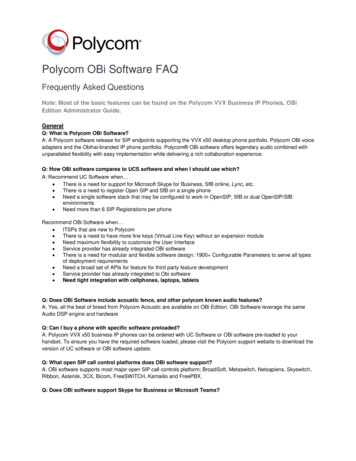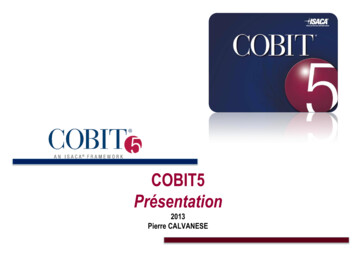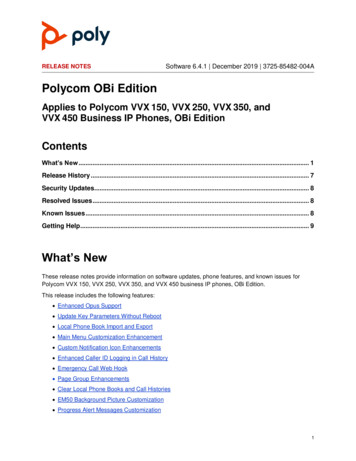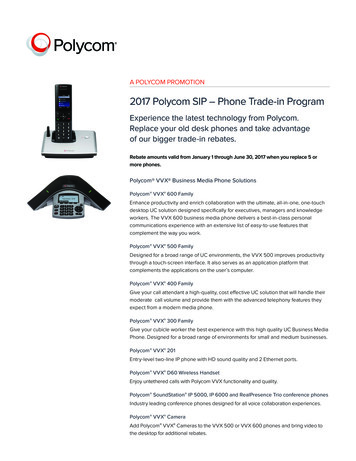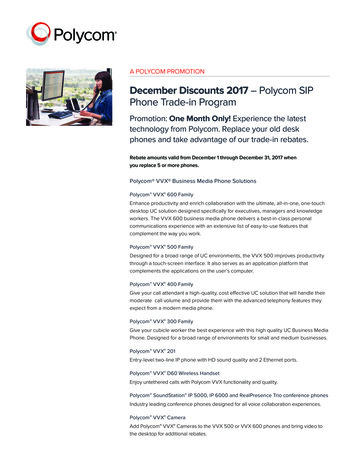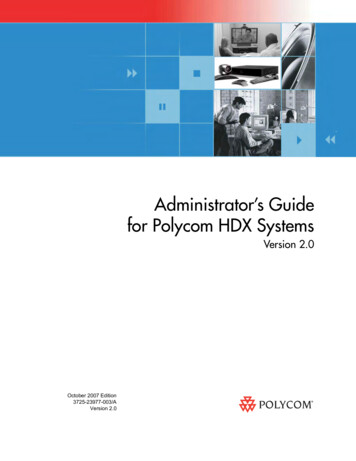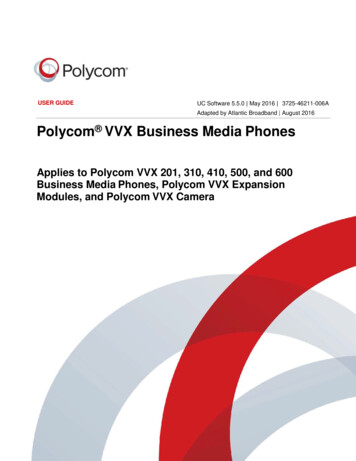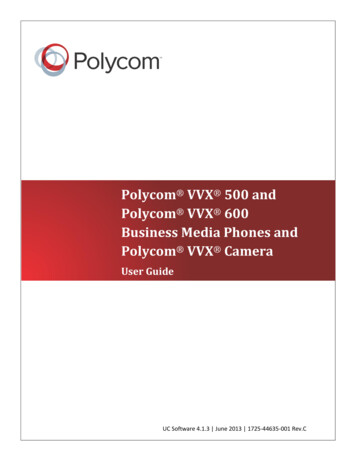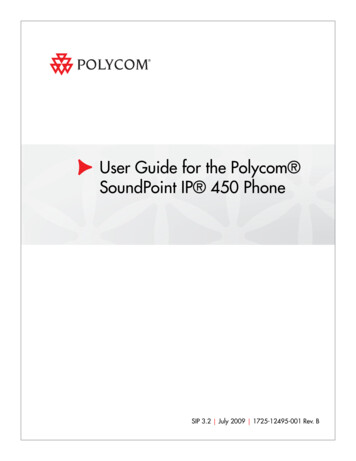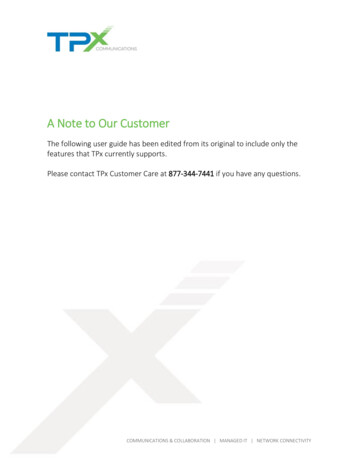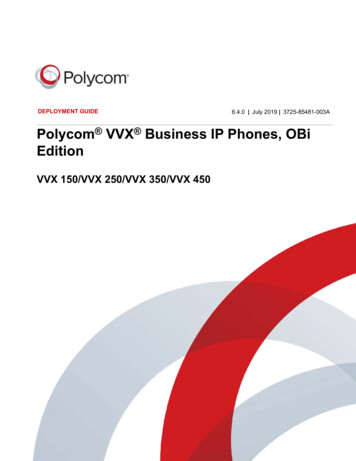
Transcription
DEPLOYMENT GUIDE6.4.0 July 2019 3725-85481-003APolycom VVX Business IP Phones, OBiEditionVVX 150/VVX 250/VVX 350/VVX 450
Copyright 2019, Polycom, Inc. All rights reserved. No part of this document may be reproduced, translated into anotherlanguage or format, or transmitted in any form or by any means, electronic or mechanical, for any purpose, without theexpress written permission of Polycom, Inc.6001 America Center DriveSan Jose, CA 95002USATrademarks Polycom , the Polycom logo and the names and marks associated with Polycom products are trademarksand/or service marks of Polycom, Inc. and are registered and/or common law marks in the United States and variousother countries.All other trademarks are property of their respective owners. No portion hereof may be reproduced or transmitted in anyform or by any means, for any purpose other than the recipient's personal use, without the express written permissionof Polycom.Disclaimer While Polycom uses reasonable efforts to include accurate and up-to-date information in this document,Polycom makes no warranties or representations as to its accuracy. Polycom assumes no liability or responsibility forany typographical or other errors or omissions in the content of this document.Limitation of Liability Polycom and/or its respective suppliers make no representations about the suitability of theinformation contained in this document for any purpose. Information is provided "as is" without warranty of any kind andis subject to change without notice. The entire risk arising out of its use remains with the recipient. In no event shallPolycom and/or its respective suppliers be liable for any direct, consequential, incidental, special, punitive or otherdamages whatsoever (including without limitation, damages for loss of business profits, business interruption, or loss ofbusiness information), even if Polycom has been advised of the possibility of such damages.End User License Agreement BY USING THIS PRODUCT, YOU ARE AGREEING TO THE TERMS OF THE ENDUSER LICENSE AGREEMENT (EULA) AT: http://documents.polycom.com/indexes/licenses. IF YOU DO NOT AGREETO THE TERMS OF THE EULA, DO NOT USE THE PRODUCT, AND YOU MAY RETURN IT IN THE ORIGINALPACKAGING TO THE SELLER FROM WHOM YOU PURCHASED THE PRODUCT.Patent Information The accompanying product may be protected by one or more U.S. and foreign patents and/orpending patent applications held by Polycom, Inc.Open Source Software Used in this Product This product may contain open source software. You may receive theopen source software from Polycom up to three (3) years after the distribution date of the applicable product or softwareat a charge not greater than the cost to Polycom of shipping or distributing the software to you. To receive softwareinformation, as well as the open source software code used in this product, contact Polycom by email atOpenSourceVideo@polycom.com.Customer Feedback We are striving to improve our documentation quality and we appreciate your feedback. Emailyour opinions and comments to DocumentationFeedback@polycom.com.Polycom Support Visit the Polycom Support for End User License Agreements, software downloads, productdocuments, product licenses, troubleshooting tips, service requests, and more.2
Before You Begin . . . . . . . . . . . . . . . . . . . . . . . . . . . . . . . . . . . . . . . . . . . . . . . . . . . 4Audience, Purpose, and Required Skills . . . . . . . . . . . . . . . . . . . . . . . . . . . . . . . . . . . . . . . . . . 4Note to End Users . . . . . . . . . . . . . . . . . . . . . . . . . . . . . . . . . . . . . . . . . . . . . . . . . . . . . . . . 4Get Help . . . . . . . . . . . . . . . . . . . . . . . . . . . . . . . . . . . . . . . . . . . . . . . . . . . . . . . . . . . . . . . . . . 5Polycom and Partner Resources . . . . . . . . . . . . . . . . . . . . . . . . . . . . . . . . . . . . . . . . . . . . 5The Polycom Community . . . . . . . . . . . . . . . . . . . . . . . . . . . . . . . . . . . . . . . . . . . . . . . . . . 5Documentation Feedback . . . . . . . . . . . . . . . . . . . . . . . . . . . . . . . . . . . . . . . . . . . . . . . . . . 5Notational Conventions . . . . . . . . . . . . . . . . . . . . . . . . . . . . . . . . . . . . . . . . . . . . . . . . . . . . . . . 5Canonical Fashion . . . . . . . . . . . . . . . . . . . . . . . . . . . . . . . . . . . . . . . . . . . . . . . . . . . . . . . 6Literal Fashion . . . . . . . . . . . . . . . . . . . . . . . . . . . . . . . . . . . . . . . . . . . . . . . . . . . . . . . . . . . 6Boolean Values . . . . . . . . . . . . . . . . . . . . . . . . . . . . . . . . . . . . . . . . . . . . . . . . . . . . . . . . . . 7Multiple Choice Values . . . . . . . . . . . . . . . . . . . . . . . . . . . . . . . . . . . . . . . . . . . . . . . . . . . . 7Parameter Values . . . . . . . . . . . . . . . . . . . . . . . . . . . . . . . . . . . . . . . . . . . . . . . . . . . . . . . . 7Getting Started . . . . . . . . . . . . . . . . . . . . . . . . . . . . . . . . . . . . . . . . . . . . . . . . . . . . . 8XML App Execution Models . . . . . . . . . . . . . . . . . . . . . . . . . . . . . . . . . . . . . . . . . . . . . . . . . . . 8Action URLs – Pull Model . . . . . . . . . . . . . . . . . . . . . . . . . . . . . . . . . . . . . . . . . . . . . . . . . . 8Action URL Feature Key . . . . . . . . . . . . . . . . . . . . . . . . . . . . . . . . . . . . . . . . . . . . . . . . 8Action URL Softkey . . . . . . . . . . . . . . . . . . . . . . . . . . . . . . . . . . . . . . . . . . . . . . . . . . . 9SIP NOTIFY – Push Model . . . . . . . . . . . . . . . . . . . . . . . . . . . . . . . . . . . . . . . . . . . . . . . . . 9Event-Driven Model . . . . . . . . . . . . . . . . . . . . . . . . . . . . . . . . . . . . . . . . . . . . . . . . . . . . . . . . . . 9Typical Application Event Flow . . . . . . . . . . . . . . . . . . . . . . . . . . . . . . . . . . . . . . . . . . . . . 10Configuring Keys to Launch Phone Apps . . . . . . . . . . . . . . . . . . . . . . . . . . . . . . . . . . . . . . . . 10Map a Line Key to a Phone App . . . . . . . . . . . . . . . . . . . . . . . . . . . . . . . . . . . . . . . . . . . . 10Map a Programmable Key to a Phone App . . . . . . . . . . . . . . . . . . . . . . . . . . . . . . . . . . . . 11Map a Softkey to a Phone App . . . . . . . . . . . . . . . . . . . . . . . . . . . . . . . . . . . . . . . . . . . . . 11Introduction . . . . . . . . . . . . . . . . . . . . . . . . . . . . . . . . . . . . . . . . . . . . . . . . . . . . . . . 12Phone Parameters and Objects . . . . . . . . . . . . . . . . . . . . . . . . . . . . . . . . . . . . . . . . . . . . . . . 13The Object Name is Just a Name . . . . . . . . . . . . . . . . . . . . . . . . . . . . . . . . . . . . . . . . . . . 14How the Phone Organizes SP Account Parameters . . . . . . . . . . . . . . . . . . . . . . . . . . . . . 14Which Objects to Configure . . . . . . . . . . . . . . . . . . . . . . . . . . . . . . . . . . . . . . . . . . . . . . . 16Macros . . . . . . . . . . . . . . . . . . . . . . . . . . . . . . . . . . . . . . . . . . . . . . . . . . . . . . . . . . . . . . . . . . . 16Parameter Macro Expansion . . . . . . . . . . . . . . . . . . . . . . . . . . . . . . . . . . . . . . . . . . . . . . . 16User-Defined Macros . . . . . . . . . . . . . . . . . . . . . . . . . . . . . . . . . . . . . . . . . . . . . . . . . . . . 18OBi Edition Phone Provisioning . . . . . . . . . . . . . . . . . . . . . . . . . . . . . . . . . . . . . . 20Phone Configuration . . . . . . . . . . . . . . . . . . . . . . . . . . . . . . . . . . . . . . . . . . . . . . . . . . . . . . . . 20Remote Phone Configuration . . . . . . . . . . . . . . . . . . . . . . . . . . . . . . . . . . . . . . . . . . . . . . 20Local Phone Configuration . . . . . . . . . . . . . . . . . . . . . . . . . . . . . . . . . . . . . . . . . . . . . . . . 21Polycom, Inc.1
ZTP Phone Customization . . . . . . . . . . . . . . . . . . . . . . . . . . . . . . . . . . . . . . . . . . . . . . . . 22Factory Reset . . . . . . . . . . . . . . . . . . . . . . . . . . . . . . . . . . . . . . . . . . . . . . . . . . . . . . . . . . . . . 22End-User ‘User’ Parameter Space . . . . . . . . . . . . . . . . . . . . . . . . . . . . . . . . . . . . . . . . . . 22Locking Parameters . . . . . . . . . . . . . . . . . . . . . . . . . . . . . . . . . . . . . . . . . . . . . . . . . . . . . 23Firmware Update . . . . . . . . . . . . . . . . . . . . . . . . . . . . . . . . . . . . . . . . . . . . . . . . . . . . . . . . . . . 23Update From the Phone Web Page . . . . . . . . . . . . . . . . . . . . . . . . . . . . . . . . . . . . . . . . . 23Update From the IVR . . . . . . . . . . . . . . . . . . . . . . . . . . . . . . . . . . . . . . . . . . . . . . . . . . . . 23Update Using the FirmwareURL . . . . . . . . . . . . . . . . . . . . . . . . . . . . . . . . . . . . . . . . . . . . 24Device Configuration Profile Formats . . . . . . . . . . . . . . . . . . . . . . . . . . . . . . . . . 26Device Profile Format . . . . . . . . . . . . . . . . . . . . . . . . . . . . . . . . . . . . . . . . . . . . . . . . . . . . . . . 26Full Profile Format . . . . . . . . . . . . . . . . . . . . . . . . . . . . . . . . . . . . . . . . . . . . . . . . . . . . . . . 26Compact Profile Format . . . . . . . . . . . . . . . . . . . . . . . . . . . . . . . . . . . . . . . . . . . . . . . . . . 29Profile Compression . . . . . . . . . . . . . . . . . . . . . . . . . . . . . . . . . . . . . . . . . . . . . . . . . . . . . 30Phone Parameters for Remote Provisioning . . . . . . . . . . . . . . . . . . . . . . . . . . . . . . . . . . . . . . 30Provisioning Scripts . . . . . . . . . . . . . . . . . . . . . . . . . . . . . . . . . . . . . . . . . . . . . . . . . . . . . . 31Provisioning Script Operations . . . . . . . . . . . . . . . . . . . . . . . . . . . . . . . . . . . . . . . . . . . . . 33SYNC . . . . . . . . . . . . . . . . . . . . . . . . . . . . . . . . . . . . . . . . . . . . . . . . . . . . . . . . . . . . . 33RPT (Report Configuration and Status) . . . . . . . . . . . . . . . . . . . . . . . . . . . . . . . . . . . 34FWU (Firmware Update) . . . . . . . . . . . . . . . . . . . . . . . . . . . . . . . . . . . . . . . . . . . . . . . 35WAIT . . . . . . . . . . . . . . . . . . . . . . . . . . . . . . . . . . . . . . . . . . . . . . . . . . . . . . . . . . . . . . 36EXIT . . . . . . . . . . . . . . . . . . . . . . . . . . . . . . . . . . . . . . . . . . . . . . . . . . . . . . . . . . . . . . 36GOTO . . . . . . . . . . . . . . . . . . . . . . . . . . . . . . . . . . . . . . . . . . . . . . . . . . . . . . . . . . . . . 36SET . . . . . . . . . . . . . . . . . . . . . . . . . . . . . . . . . . . . . . . . . . . . . . . . . . . . . . . . . . . . . . . 37CLR . . . . . . . . . . . . . . . . . . . . . . . . . . . . . . . . . . . . . . . . . . . . . . . . . . . . . . . . . . . . . . 37Operation Error Codes . . . . . . . . . . . . . . . . . . . . . . . . . . . . . . . . . . . . . . . . . . . . . . . . . . . 37Provisioning Script Examples . . . . . . . . . . . . . . . . . . . . . . . . . . . . . . . . . . . . . . . . . . . . . . 38Script Execution Model . . . . . . . . . . . . . . . . . . . . . . . . . . . . . . . . . . . . . . . . . . . . . . . . . . . 39Phone Behavior on Processing a Profile . . . . . . . . . . . . . . . . . . . . . . . . . . . . . . . . . . . . . . 40Force Device Sync with SIP NOTIFY . . . . . . . . . . . . . . . . . . . . . . . . . . . . . . . . . . . . . . . . 41Firewall Considerations . . . . . . . . . . . . . . . . . . . . . . . . . . . . . . . . . . . . . . . . . . . . . . . . . . . 41Creating Profiles for Deployment . . . . . . . . . . . . . . . . . . . . . . . . . . . . . . . . . . . . . . . . . . . . . . . 41Backing Up a Profile from the Phone Web Page . . . . . . . . . . . . . . . . . . . . . . . . . . . . . . . 42Create the Profile Manually . . . . . . . . . . . . . . . . . . . . . . . . . . . . . . . . . . . . . . . . . . . . . . . . 43Secure Provisioning . . . . . . . . . . . . . . . . . . . . . . . . . . . . . . . . . . . . . . . . . . . . . . . . . . . . . . . . . 43Using HTTPS . . . . . . . . . . . . . . . . . . . . . . . . . . . . . . . . . . . . . . . . . . . . . . . . . . . . . . . . . . 43Device Authentication . . . . . . . . . . . . . . . . . . . . . . . . . . . . . . . . . . . . . . . . . . . . . . . . . . . . 43Server Authentication . . . . . . . . . . . . . . . . . . . . . . . . . . . . . . . . . . . . . . . . . . . . . . . . . . . . 44Requesting an SSL Certificate from Polycom . . . . . . . . . . . . . . . . . . . . . . . . . . . . . . . . . . 45Using Encrypted Profiles . . . . . . . . . . . . . . . . . . . . . . . . . . . . . . . . . . . . . . . . . . . . . . . . . . 45Polycom, Inc.2
Automating Phone Preparation for Deployment . . . . . . . . . . . . . . . . . . . . . . . . . . . . . . . . . . . 46Profile Listings for the Last Example . . . . . . . . . . . . . . . . . . . . . . . . . . . . . . . . . . . . . . . . . 47Polycom, Inc.3
Before You BeginThis guide describes how to develop and deploy XML-based applications to configure Polycom VVX Business IP Phones, OBi Edition.The information applies to the following OBi Edition phones: VVX 150, OBi Edition VVX 250, OBi Edition VVX 350, OBi Edition VVX 450, OBi EditionAudience, Purpose, and Required SkillsThis guide is written for a technical audience involved in developing and deploying XML-based applicationsfor OBi Edition phones. This audience includes Internet Telephony Service Providers (ITSP), ManagedService Value Added Resellers (VAR), Internet Telephony Professionals, and Technology Hobbyists.You must be familiar with the following concepts before beginning: Current telecommunications practices, protocols, and principles. Telecommunication basics, video teleconferencing, and voice or data equipment. OpenSIP networks and VoIP endpoint environments.Note for Australian readers: Throughout this document, we refer to ITSP – treat this term the same as youwould for VSP (Voice Service Provider).This document targets the following audiences: Service providers who to deploy and remotely manage Polycom VVX business IP phones, OBiEdition, using a central provisioning system. VARs planning to support customers remotely, managing OBi Edition phones via a centralprovisioning system. Power users of OBi Edition phones who want to remotely manage their phones for their friends andfamily.Note to End UsersThis guide targets phone administrators who manage large installed bases.End users are highly encouraged to use the OBiTALK web portal at www.obitalk.com to configure andmanage their OBi devices, or to perform management tasks locally by using the phone’s native web portal,accessible by logging into the phone from any PC with a web browser. See the Polycom VVX BusinessIP Phones, OBi Edition User Guide for more information about your phone’s native web portal.Polycom, Inc.4
Before You BeginGet HelpFor more information about installing, configuring, and administering Polycom products, see Documents &Software at https://support.polycom.com.Polycom and Partner ResourcesPolycom has a number of options available to customers who need help with their Polycom OBi Editionproducts. In addition to this guide, the following documents and other resources provide more details: Visit the OBi Edition documents and guides found at https://documents.polycom.com Polycom VVX Business IP Phones, OBi Edition Administration Guide Polycom OBi Edition Provisioning Guide Polycom VVX Business IP Phones, OBi Edition User Guide For Polycom UC Software releases and documentation, see Polycom Voice Support. For user guides for Polycom voice products, refer to the product support page for your phone atPolycom Voice Support. For help or technical support for your phones, you can search for Polycom documentation at thePolycom Unified Communications (UC) Software Resource Center. You can find Request for Comments (RFC) documents by entering the RFC number athttp://www.ietf.org/rfc.html. Email the Polycom OBi Edition Service Provider Support Team at: Obi.SPSupport@Polycom.comTo find all Polycom partner solutions, see Strategic Global Partner Solutions.The Polycom CommunityThe Polycom Community gives you access to the latest developer and support information. Participate indiscussion forums to share ideas and solve problems with your colleagues. To register with the PolycomCommunity, simply create a Polycom Online account. When logged in, you can access Polycom supportpersonnel and participate in developer and support forums to find the latest information on hardware,software, and partner solutions topics.Documentation FeedbackWe welcome your feedback to improve the quality of Polycom documentation.You can email Documentation Feedback for any important queries or suggestions related to thisdocumentation.Notational ConventionsThis guide provides device configuration parameters and their values in the following formats: Canonical fashion Literal fashionPolycom, Inc.5
Before You BeginBoth notational conventions point to the same parameters, but their appearances are different.The canonical fashion simplifies locating parameters on the phone’s native web portal or on OBiTALK.com.The literal fashion is required when provisioning or writing OBIPhoneXML apps.Canonical FashionThis example shows the format of the canonical fashion. Parameter Group Name::ParameterName Parameter Value {replace with actual value}The Parameter Group Name is the heading of the parameter group on the left side panel of the device localconfiguration or OBiTALK Configuration web page. This string may contain spaces. When a group headinghas more than one level, each level is separated with a –, such as: Services Providers - ITSP Profile A – SIP:The ParameterName is the name of the parameter as shown on the web page and MUST NOT CONTAINANY SPACES. Parameter Group Name and ParameterName are separated by two colons (::), as shownin the first example above.The Parameter Value is the literal value to assign to the named parameter and may contain spaces. Youcan omit Parameter Group Name or its top-level headings when the context is clear. For example: SP1 Service::AuthUserName 4082224312 ITSP Profile A - SIP::ProxyServer sip.myserviceprovider.com ProxyServerPort 5082Literal FashionThese examples show the format of the literal fashion. The literal fashion is used when provisioning orwriting OBIPhoneXML apps. ParameterGroupName.ParameterName.Parameter Value {replace-with-actual-value} ame.Parameter ValueThe ParameterGroupName. is the name of the first parameter group in literal fashion. This string MUSTNOT CONTAIN ANY SPACES, and always is terminated with a period, as shown. More than oneParameterGroupName. may be used. The ParameterGroupName. is case-sensitive.The ParameterName. is the name of the parameter, and always is terminated with a period, as shown. Thisstring MUST NOT CONTAIN ANY SPACES. The ParameterName. is case-sensitive.The Parameter Value is the literal value to assign to the named parameter and may contain spaces. TheParameter Value is not case-sensitive, but it MUST EXACTLY MATCH the value when one or morechoices are available.When using the literal fashion in your XML, you need to exactly match the text string forParameterGroupName.ParameterName.Parameter Value, but text formatting such as bold face is notrequired and will be removed when your script or app is processed.Polycom, Inc.6
Before You BeginBoolean ValuesYou can identify parameters that take a Boolean value on your phone’s configuration web pages by a checkbox next to the parameter name. Throughout the document, we may loosely refer to a Boolean value as“enable/disable” or “yes/no”, but the only valid Boolean parameter values to use in a phone configurationfile is either true/false or True/False (case-sensitive). This is equivalent to selecting or clearing thecheck box on the configuration web pages.Multiple Choice ValuesYou must provision parameters that take one of several valid options from a drop-down list on the devicemessage with string values that match exactly one of those choices. Otherwise, the device uses the defaultchoice. Matching the provisioned value against valid strings is case-sensitive and doesn’t allow extraspaces.Parameter ValuesWhen entering a parameter value from the web page or via provisioning, avoid adding extra white spacesbefore or after the parameter value. If the value is a comma-separated list of strings or contains attributesafter a comma or semicolon, avoid adding extra white space before and after the delimiter.For example: CertainParameter 1,2,3,4;a;b;cIf a parameter value can include white spaces, such as X DisplayLabel, use just a single space and noextra space before and after the value.For example: X DisplayLabel My New ServicePolycom, Inc.7
Getting StartedThe OBi Edition VVX business IP phones provide a programmatic interface for developing third-partyapplications that you can download and execute on the phones. You can develop these applications (calledOBiPhoneXML apps) using a proprietary mark-up language called OBiPhoneXML to create solutionsinvolving deployed phones and servers.Typical applications include: Access to corporate directories Voicemail navigation Call queue monitoring Integration with customer databasesXML App Execution ModelsAn XML app comprises one or more scripts written in OBiPhoneXML that you download and executesequentially on the phone to achieve the desired behavior. The execution of an app starts with the first XMLscript, also known as the landing script. Depending on the interaction with the user and relevant eventshappening on the phone, the phone can invoke and execute additional scripts. The server that generates orstores the scripts is the (XML) App Server.The phone uses two models to execute an XML app: The pull model is where the phone pulls the landing script from a preconfigured action URL triggeredby some event on the phone (such as user pressing a feature key). The method supported by thephone for pulling is HTTP/HTTPS GET. The push model is where the App Server pushes the script to the phone for execution. The methodsupported by the phone for pushing is SIP NOTIFY with the Event: obihai-xml and Content-Type:application/xml.Action URLs – Pull ModelThe OBi Edition phones support the pull model by accepting the configuration of the app URL into the phoneto associate with a softkey or a feature key, such that when the key is pressed, the phone downloads thecorresponding script from the given URL, applies the script, and executes the script. This URL is called anAction URL.Action URL Feature KeyTo invoke an Action URL with a feature key, the feature must be set up with the function Action URL, andthe URL of the landing script must be specified in the Number field of that feature key. The Name field of thePolycom, Inc.8
Getting Startedfeature may also be configured with a friendly name to be displayed on screen to identify the functionalityof the script. For example:Function Action URLNumber xml?user jsmith&model 1032Name Main MenuAction URL SoftkeyTo invoke an Action URL with a softkey, include a softkey with the id acturl in a softkey set parameter, withthe URL specified in a url attribute. For example, the default Home softkey set is: redial,cfa,dnd,missed lines. You can replace the fourth softkey with an Action URL (all one line):redial,cfa,dnd,acturl;url ”http://10.1.1.123/test.xml?user abc&model 1032”;label ”Main Menu”Note that the value of the url attribute MUST be XML-escaped. For example, & must be specified as&.SIP NOTIFY – Push ModelAs it is typically not feasible for the App Server to send HTTP requests to the phone, the phone only acceptsserver-pushed XML via SIP NOTIFY requests sent to it over one of the enabled SPn service channels. TheSIP NOTIFY must have the Event: obihai-xml with the Content-Type: application/xml.The phone also accepts XML pushed via HTTP POST sent to the built-in Web Server port with the followingURL: http://{device-ip-address}/obihai-xml with the Content-Type: application/xml.When the XML pushed to the phone contains one or more ExecuteItem elements, the phone replies tothe request with the inclusion of a message body that is an ObihaiIPPhoneExecuteResponse containing one or more ExecuteItem elements in the same order as the corresponding ExecuteItem elements in the original request. The ExecuteItem element in the response containsa result attribute that indicates the status of executing the item. It may contain additional information as aresult of carrying out the ExecuteItem element.For example, when the following XML is pushed to the phone to make a call: ObihaiIPPhoneExecute ExecuteItem id ”1” URI ”Dial:14089991234”/ /ObihaiIPPhoneExecute The following message body may be included with the response returned by the phone: ObihaiIPPhoneExecuteResponse ExecuteItem id ”1” result ”200 OK” call-id ”f234ab97”/ /ObihaiIPPhoneExecuteResponse Event-Driven ModelThe phone is programmed to perform specific actions in response to a prescribed set of events.Polycom, Inc.9
Getting StartedEvents consist of: User actions (such as a key press) Telephony events (such as an incoming call) Server-to-phone push messages (via SIP NOTIFY Events) Programmed timer expirationsActions consist of: Activating internal phone features Playing audio files and tones Phone screen updates Phone-to-server pull requests (via the HTTP protocol)The phone configuration profile specifies the initial state and event triggering hooks for each application(such as through softkey configuration).Typical Application Event FlowIn a typical application, a feature key is configured with an application-specific URI. When you press thatkey, the phone activates the URI, sending an HTTP GET request to an application server.The server response to this request consists of an XML page, whose contents specify both visual contentfor the phone to display, and also actions to perform under various triggers. In this way, the phone displayacts as a kind of browser on behalf of the application. User actions or other events then trigger the phoneto perform a prescribed action, and possibly generate additional server requests for updated XML content.Thus, the phone-side of the application design revolves around the XML content of messages (pages) sentby the server to the phone. These are either synchronous responses to phone HTTP requests, or elsemessages pushed by the server to the phone asynchronously (via SIP NOTIFY Events).Configuring Keys to Launch Phone AppsYou can preconfigure the phone to map line keys and programmable keys to phone applications. Thisenables a phone user to run an application by pressing the specified key. For this use case, the key isconfigured with the URL from which to fetch the topmost page of the application.Map a Line Key to a Phone AppConfigure the following parameters to set LineKey{n} as the trigger for running an application:Configuration Parameters for a Line KeyConfiguration ParameterProgrammed ction URL”Polycom, Inc.10
Getting StartedConfiguration Parameters for a Line KeyConfiguration ParameterProgrammed ion display nameVoiceService.1.Phone.LineKey.{n}.NumberURL from which to fetch the application’s topmost XML page. Thephone generates an HTTP GET request to the server when thekey is pressed.Map a Programmable Key to a Phone AppAlternatively, if a programmable key is desired as the trigger, the corresponding “ProgKey” entries wouldbe configured in place of “LineKey”.Upon receiving the XML page in response to the HTTP GET, the phone interprets the contents as describedin the following sections.Map a Softkey to a Phone AppYou can also configure a softkey to invoke an application, with a similar syntax as in the following example,inserted in a softkey set parameter (under the Soft Keys configuration page):acturl;url el ”Local Tests”Polycom, Inc.11
IntroductionBefore you use your OBi Edition phone, take a few moments to familiarize yourself with its features and userinterface.The terms “the phone” and “your phone” refer to any of the OBi Edition VVX business IP phones. Unlessspecifically noted in this guide, all phone models operate in similar ways.As you read this guide, keep in mind that certain features are configurable by your system administrator ordetermined by your network environment. As a result, some features may not be enabled or may operatedifferently on your phone. Additionally, the examples and graphics in this guide may not directly reflect whatis displayed or is available on your phone screen.The OBi Edition phones share the same functionalities with all other Polycom business IP phones: Support for all standard SIP-based IP PBX and ITSPs/VSPs. Support for 3CX PBX and uaCSTA interoperability. Suited for all service provider and enterprise deployment environments, regardless of size. Ideal for self-service installations. Home users, small business owners, or corporate IT departmentscan easily install, set up, and manage these phones. Seamless integration with popular softswitch architectures Cloud management enabled via OBiTALK.com with both a user portal and an ITSP partner portal withan optional REST API.An area available only to service providers, the https://www1.OBiTALK.com ITSP portal may alsobe used by service providers for phone provisioning, management, and troubleshooting. TheOBiTALK ITSP portal can be used independently as the sole system for secure management ofOBi Edition phones or in conjunction with an existing centralize
Telecommunication basics, video teleconferencing, and voice or data equipment. OpenSIP networks and VoIP endpoint environments. Note for Australian readers: Throughout this document, we refer to ITSP - treat this term the same as you . IP Phones, OBi Edition User Guide for more information about your phone's native web portal. Before You .
